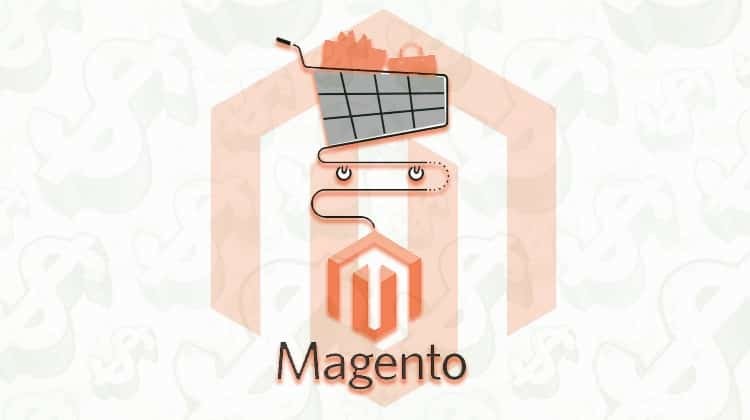by Cydney Hatch • June 15, 2018
A Magnificent Magento Tutorial: How To Get Started and Why
Magento is one of the world’s biggest ecommerce platforms and has been chosen by over 200,000 retailers worldwide, ranging from small start-ups to well-known companies like Coke, Burger King to even Murad and Zumiez! In fact, every year Magento handles over $155 billion in gross merchandise volume!
Crazy huh?
So, do you want to learn more about this powerhouse of a platform? Great! In this magnificent Magento tutorial, you will learn everything you need to know about this ecommerce platform and who is the best fit to use it!
Let’s get started!
What is Magento?
Magento is a content management system that was created specifically for ecommerce, especially medium or large-scale businesses where you will need as much automation, flexibility and features as possible.

Magento is an ecommerce platform built on open source tech which provides ecommerce businesses owners with a flexible shopping cart system, as well as control over the look, content and functionality for their online storefront. Magento offers powerful marketing, search engine optimization, and catalog-management tools.
There are three versions of Magento:
- Magento Open Source: The free version of Magento, which is used by the majority of Magento users. Community has lots of great features and is suitable for most ecommerce business owners.
- Magento Commerce: Magento Commerce is their hosted solution, which is similar to an offering provided by the popular ecommerce platform, Shopify. Magento Commerce is more suited to smaller retailers.
- Magento Enterprise: premium version offers more functionality that adds value to enterprise-level retailers. This version of Magento is very expensive and is not necessarily the best option for mid-level retailers. This option is for the “big boys.”
How Much is Magento?
While Magento is a very powerful ecommerce platform, there are a lot of expenses associated with it, especially as you customize and build it out. The price of a Magento store can vary depending on what you are needing to create so coming up with a price tag is tough. The final price of a Magento ecommerce website varies and depends on your overall business goals.
Doing extensive research is a good idea with this ecommerce platform because you will need a developer at some point to at least help set up the site itself. SheroCommerce stated a rough pricing bracket stating a custom Magento website could cost anywhere from $42,000.00 – $100,000.00 and up.

At the end of the day, looking at price-point, Magento is a great option for bigger, established businesses who can afford the developers and skills required to set up the many moving pieces.
But, do not let this discourage you. If you want to evaluate if Magento is the right cloud based platform for your business, they offer you a free 30 day opportunity to test it all out.
Magento Tutorial: Getting Started with Magento
Before you install Magento, there are a set of minimum requirements:
- Your system needs to meet the requirements discussed in Magento System Requirements.
- You must complete all prerequisite tasks discussed in Prerequisites.
- After you log in to the Magento server, you’ll need to switch to the Magento file system owner.
In my example of setting up a Magento store, I will use “Magento Commerce” :
1. Go to Magento’s Site
Head over to the Magento website and take a look around. There are a lot of elements and things you should know before setup. Much of it is written for developers, so don’t worry if it’s over your head because it honestly will be for most people. When you are ready sign up, look for one of the omni-present links to a trial of Magento Commerce and start your free trial!
2. Manage Your Admins Page
The confirmation email will include useful URL links that will connect you to your store admin page.
This will take you to your store dashboard and quickstart wizard which will be the programs you will need to master to understand the platform. It is your control center!
3. Choose Your Hosting
The Magento database is resource heavy and requires strong servers. There are several companies, such as Nexcess and SiteGround, which specialize in hosting online stores powered by Magento. The pricing of hosting for Magento ranges between $3.95 per month with Siteground and can go up to $114 per month if you want to power multiple stores.
4. Pick A Store Theme
Most stores have their own developers to build unique themes in accordance with their branding strategy. A cheaper solution would be to purchase a ready-made theme from Themeforest and customize it to according to your preferences.
To fully install your theme, click “Save and Apply” in the top menu.
5. Customzie and Design
Now that your store’s set up, it’s time to personalize it to your business brand! In your store’s quick start wizard, hover your mouse over the “Design” menu option. In the submenu that opens, click “Select & Customize Your Design.” This will open a small window explaining how Magento themes work.
Click Continue, which will take you to the Theme Editor. From there you can customize and make your storefront your own! I again suggest getting the opinions and help of a developer as this process might be a bit complex.
Add Store Functionalities Using Extensions
Magento extensions are applications that can be installed onto your store to add more features. Magento offers a wide variety of extensions and add ons on their Magento Connect page with prices varying from 100% free and up to hundreds of dollars. Price is normally determined by how much an extension can increase your potential revenue. So, more value, more money.
6. Set Up Your Database
Now that you have your hosting, extensions and theme set up you are now going to set up your database, control center, ecommerce “death star.” This will be on your admins page where you can setup your:
- Store name
- Email address for notifications
- Shipping methods
- Payment methods
- Email marketing services
- Products
- Product categories
- Additional settings required by your installed extensions
7. Add Your Products
Now that you’ve snazzed-up your store with a theme and all of the details, you’re ready to stock your shelves with products. Under the “Products” menu, select “Create New Products.”
Next, you’ll be asked for an “Attribute Set” and whether you want to use Complex Product Types. Leave the attribute at default as you can change this later.
The Complex Product Types option lets you list virtual products, gift cards, bundled products, configurable products and grouped products. For now, we’ll just add a simple product, so leave this option de-selected.
Click “Continue.”
8. Fill In Product Details
You’ll now be asked to complete the product details. To me, this is the most important part of a store setup. After all, the quality of your descriptions and images are what will make your customers want to buy the products.
Details should include:
- Creative Product Names
- Informative Descriptions
- SKU Numbers
- Delivery Details
- Weight & Material Make
- Sizing
- Return policies or other meaningful business information
Special product options include “Status,” which lets your select whether the product is enabled (i.e. live) in your store, and visibility, which allows you to specify whether the product can be found in the search bar, catalogue, in both, or neither.
When you’re done, click “Save and Continue Edit.”
9. Add Prices and Images
To add a price to your product, click “Prices” in the left hand menu. Complete the required fields, which includes tax class, then click “Save and Continue Edit.”
To add product images, click “Images” in the left hand menu and download as you would for most websites. You can then select which image you want to be the base image, small image and thumbnail.
Click “Save and Continue Edit.”
10. Add SEO Keywords
In the left hand menu, click “Meta Information.” Here, you can choose the title and description that will show up in search engines, and add keywords for SEO purposes. This will be helpful driving traffic to your site so although its ANOTHER step, it’s an important one!
11. Setup Payments and Shipping
Um, you need to set up payment and shipping or you will not have a business! To set up these options you click on the “Start My Store” button in the top left. It is a fairly easy process like other ecommerce platforms.
12. Let’s Go LIVE!
So, you are set up, designed and ready to go! To launch your store LIVE click on the “Get Going” menu select “Launch Your Store.”
Congratulations you are now selling on Magento!
Yay!

Now that you have an understanding of what Magento is and how to set up a storefront using its services, let’s see who this platform works best for (in my opinion.)
Who Should Use Magento?
Magento is honestly a beast of an ecommerce platform.
It has an incredibly deep knowledge and powerful user interface, hundreds of settings and requires a lot of knowledge for storefront setup and running it well. Whether you’re moving an existing store or starting a new one from scratch, if you’re not a guru Magento developer, starting out with Magento will require a learning curve as well as a good developer to hold your hand! (honestly, you will really need it).

In my opinion, Magento is one of the hardest ecommerce platforms to use for the average person and finding online resources to help are hard to find. Magento is primarily designed for large growing enterprises and businesses, so I would encourage smaller ecommerce businesses to look elsewhere before coming to Magento. Although their customizations and powerful tools and extension are valuable, it will definitely come at a hefty price.
Hiring a developer and having them become your best friend is a really realistic scenario you will be dealing with using Magento. I think it would take a competent developer twice as much time to build something on Magento than it would on a platform like Shopify so that comes with the costs of time, investment and a lot of headaches via communicating back and forth with a developer to make this storefront just right.
If you’re looking for a simple shopping site that looks pretty, works well and supports multiple sites you may want to look at simplier and more user-friendly options like Shopify, WooCommerce, Wix or Weebly. Magento is a beast to work with, so why not look for quicker, more cost and time efficient options?
A Conclusion
This article is not intended to knock Magento as it’s an incredibly diverse and powerful website to use for ecommerce. Under the right circumstances, I think Magento could be a really great fit for specific businesses. But, for everyone else, it is extremely frustrating working with it.
Overall, Magento is a highly flexible and scaleable platform but it will require you to self-master coding or hire a professional Magento developer to take the reins and create the storefront for you.
Magento might not be the best fit if you aren’t looking for an intensive site that requires lots of money, time and talent. Even if you’re a DIY fan, forget it unless you want to spend countless hours reading up, watching dry tutorials and searching unhelpful chat threads.
Mangeto is for the big boys, big leagues and big efforts!
If you have anything to add to this article, please feel free to leave a comment below! If you want some help deciding on which ecommerce platform best works for your ecommerce business please feel free to get in touch!
What are your thoughts on Magento? Do you agree or disgree with my opinions on the useability of the platform? Comment below! I would love to hear your thoughts!





